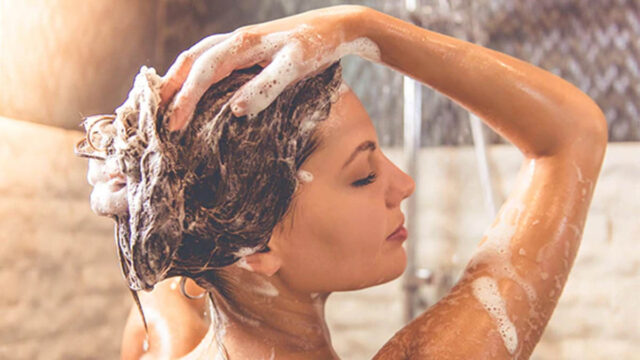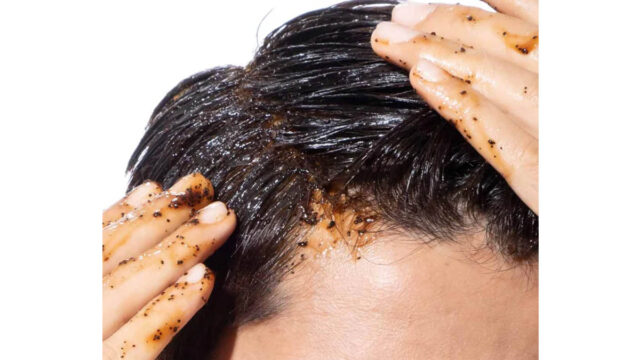Have you ever caught sight of flaky, dead skin on your hair or your shoulders? The first thing you would assume it to be is dandruff and start treating it right away! You might want to think a minute before treating it because it could be a scalp buildup too. Let’s know more about what scalp buildup is.
What Is Scalp Buildup?
Scalp buildup occurs when an oily secretion accumulates along with sweat, dirt, dead skin and other hair products, or a combination of all. It often causes a flaky scalp and can be easily cured. It shares similar symptoms as dandruff-like:
- Itchiness
- Oily or crusty skin
- Redness of the skin
- Pungent odour
5 Possible Causes Of Scalp Buildup
There are different causes of a buildup on the scalp. Knowing which one you’re dealing with is crucial. This will help you find the right treatment. Additionally, you will learn how to remove scalp buildup in the future.
1. Natural Buildup
As the word suggests, this scalp gunk is built up naturally by the body.
2. Sebum
Our scalp produces a natural waxy oil called sebum. This waxy buildup on the scalp protects our scalp from skin infection and keeps it moist. Nevertheless, if the body produces additional sebum, it leads to a sebum buildup on the scalp or development of scalp gunk.
3. Dead skin cells
When our skin cells die, they’re supposed to shed. New ones need to grow to replace the old ones. But for some of us, these cells take more than usual time to shed and, thus, lead to build-up on the scalp.
4. Sweat
Along with other natural secretions, our body produces sweat. If you’re an active person, you might sweat more than others. When sweat combines with sebum and dead cells leads to buildup on the scalp.
5. Product Buildup
This residue from regular hair products could also lead to scalp buildup. Many products contain substances that can stick to your hair forming a waxy buildup on the scalp, if not rinsed out properly when you wash it. Residue of the following products usually cause waxy buildup on scalp:
- Shampoos & conditioners
- Hair Gels
- Styling creams, oils and foams
- Oils
Using excessive hair care products, improper hair rinsing, and skipping hair washing can cause a buildup on the scalp.
6 Pro-Home Remedies To Remove A Buildup On The Scalp
Here’s a list of 6 at-home remedies on how to remove scalp buildup:
1. Regular Shampooing & Brushing Of Hair
It is essential to wash your hair every two-three days (or more in case you have oily hair or work out regularly). A correct shampoo for scalp buildup would be the one which is free of sulphate and chemical. When rinsing your hair, use warm water rather than hot water, which can dry out the scalp and cause itching and flaking.
Regular brushing is important as it stimulates blood flow and hair growth.
2. Scalp Exfoliation
Exfoliation is a process to remove dead skin cells and built-up dirt, and debris on the scalp. You can purchase exfoliate products available in the market or make your own by blending the following ingredients:
- 1 tablespoon of brown sugar
- 2 tablespoons of dry oatmeal
- 2 tablespoons of hair conditioner
Don’t exfoliate more than twice weekly. Anything more can increase sebum production and lead to a sebum buildup on the scalp, also known as sebum gunk.
3. Apple Cider Vinegar Cleanse
Apple Cider Vinegar has antibacterial and antifungal properties, meaning it can kill dandruff-causing yeast on the scalp.
You can cleanse your hair by following these steps:
- Add two tablespoons of apple cider vinegar to an 8-ounce glass of warm water.
- Then, shampoo and rinse the hair as usual.
- Slowly, pour the mixture onto your head.
- Let it rest for 2-3 minutes.
- Rinse with warm water, massaging the scalp gently.
4. Lemongrass Essential Oil
Lemongrass essential oil is easily available online or in specialty retail stores. Research suggests that lemongrass oil may be an effective treatment for dandruff. For treating dandruff, the solution containing 10 per cent lemongrass proved to be the most effective.
5. Use Tea Tree Oil
Get yourself a bottle of tea tree oil with a dropper. Pour 3 to 4 drops twice a week to get the best results. If you still want to dilute it you can use a carrier oil like almond oil, jojoba oil etc.
6. Try Witch Hazel
The solution is regarded by some as a miracle; others say it doesn’t work. So if it works for you, then you should start including this in your hair care routine right away! Witch hazel helps in reducing the itchiness and reduces flakes, making it an excellent cleansing remedy.
5 Easy Ways To Prevent A Buildup On The Scalp
1. Using The Correct Shampoo
First, understanding and selecting a shampoo that suits your type is important. Shampoos are sold in numerous formations like:
- Average hair
- Dry and damaged hair
- Oily hair or
- Medicated hair
Reading the ingredient list is important to understand what ingredients your shampoo contains.
2. Avoid Excessive Use Of Hair Products
Hair products can be a way to keep hair healthy and styled. But access to anything is not good. Apply these products sparingly and add as little to your scalp as possible.
3. Limit Hair Colouring & Styling
Using straighteners, blow dryers, curlers or any sort of heat styling tools make the scalp dry and stimulate excess oil production with leads to buildup. Hair dyes block the hair follicles leading to an infection or hair fall.
4. Follow A Hair Care Routine
Shampooing and conditioning your hair in the right way on a regular basis ensures healthy hair. Shampooing helps to take off dead cells, excess oils and dirt from the hair and scalp, and conditioning helps in protecting the hair cuticles.
5. Brushing Your Hair Everyday
Brush your hair gently with a wide-toothed comb to avoid tangles and spread the oils evenly. Separate your hair into sections and brush it gently without breaking or damaging it.
When To Seek Medical Help?
See a doctor if sebum buildup on your scalp causes you to experience difficulty managing your hair, even after you’ve tried home treatments. If you observe any of the below symptoms, see the doctor immediately as these could also be signs of secondary skin infection as well.
- Increasingly painful, red, and swollen skin
- Pus-filled blisters
- Sores with crusting
- Fever with chills
Doctors can determine the cause of flaking and develop a treatment plan that will prevent recurrence by removing the buildup.
FAQs
1. Does sebum buildup cause hair fall? Is it irreversible?
Yes, any hair infection leads to hair loss. There are commercial shampoos specially formulated to treat sebum buildup. These gently remove sebum without damaging your hair or the skin of your scalp.
2. What does oozing scalp mean?
When your scalp begins to ooze, a sore has probably become inflamed, irritated, or popped. As a result, it’s very important to identify the kind of sores and address the underlying cause.
3. What are hard bumps on the skin?
Many conditions can produce hard bumps on your scalp, but they go away with minor scrubbing and a thorough rinse.
4. Should I wash my hair every day if I have a buildup on the scalp?
Yes, washing your hair every day is the most crucial thing you can do to treat the buildup on your scalp and also prevent how to remove product buildup from the hair. Use a medicated shampoo every day until your symptoms subside. After that, start shampooing once or twice per week.
An oily scalp isn’t necessarily a cause for concern. A little oil’s good for your hair health. A buildup on the scalp buildup looks different on everyone. For some people, it’s itchy scales, whereas others may experience tenderness and soreness. Nevertheless, it’s equally important to clean up, since you don’t want gunk lingering on your scalp for too long. And now that you know how to remove this buildup, your scalp will surely thank you for trying one of these above methods.
Open up like never before and participate in conversations about beauty, entrepreneurship, mental health, menstrual & sexual health, and more. Desi women, join our community NOW!



